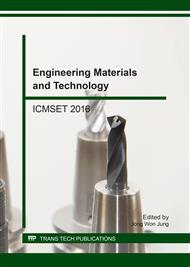[1]
M. S. Ostapenko, D. S. Vasilega. An industrial and sociological research of consumers' requirements to lathing tools, Key Eng. Mater. 684 (2016) 429-434.
DOI: 10.4028/www.scientific.net/kem.684.429
Google Scholar
[2]
E. V. Artamonov, M. S. Ostapenko, D. S. Vasilega. Improvement of efficiency of modular tooling systems application based on qualimetric evaluation, World Appl. Sci. J. 25(9) (2013) 1275-1279.
Google Scholar
[3]
M. S. Ostapenko, D. S. Vasilega, Method for metal-cutting tool quality evaluation, Appl. Mech. Mater. 379 (2013) 49-55.
DOI: 10.4028/www.scientific.net/amm.379.49
Google Scholar
[4]
D. S. Vasilega, M. S. Ostapenko. Efficiency improvement of metal lathing by using of the assembly machine tools quality evaluation technique, Key Eng. Mater. 684 (2016) 421-428.
DOI: 10.4028/www.scientific.net/kem.684.421
Google Scholar
[5]
E. V. Artamonov, D. S. Vasilega, A. M. Tveryakov. Increasing machining efficiency of components made of hard-processing materials, Appl. Mech. Mater. 770 (2015) 34-39.
DOI: 10.4028/www.scientific.net/amm.770.34
Google Scholar
[6]
M. S. Ostapenko, A. M. Tveryakov. Enhancement of the assembly lathing tools quality evaluation methodology, Key Eng. Mater. 684 (2016) 435-439.
DOI: 10.4028/www.scientific.net/kem.684.435
Google Scholar
[7]
E. V. Artamonov, D. S. Vasilega, M. S. Ostapenko. Methods of considering reliability in the composite metal cutting tools' quality evaluation procedure for, Appl. Mech. Mater. 770 (2015) 216-220.
DOI: 10.4028/www.scientific.net/amm.770.216
Google Scholar
[8]
Y. Klochkov, A. Its, I. Vasilyeva. Development of FMEA method with the purpose of quality assessment of can stock production, Key Eng. Mater. 684 (2016) 473-476.
DOI: 10.4028/www.scientific.net/kem.684.473
Google Scholar
[9]
A. D. Makarov. Optimization of Cutting Processes, Mechanical Engineering, (1976), p.278.
Google Scholar
[10]
E. V. Artamonov, D. V. Vasilyev. Determining the optimal cutting speed in turning by composite cutters on the basis of the chip. Russian Eng. Res. 34(6) (2014) 404-405.
DOI: 10.3103/s1068798x14060069
Google Scholar
[11]
E. V. Artamonov, D. S. Vasilega, A. M. Tveryakov. Determining the hard-alloy cutting plates' maximum-performance temperature, Russian Eng. Res. 34(6) (2014) 402- 403.
DOI: 10.3103/s1068798x14060057
Google Scholar
[12]
E. V. Artamonov, M. O. Chernyshov, T. E. Pomigalova, D. V. Vasilyev. Extending the life of replaceable cutting plates in composite tools, Russian Eng. Res. 35(1) (2015) 61-63.
DOI: 10.3103/s1068798x15010049
Google Scholar
[13]
V. P. Astakhov, M. O. M. Osman. Correlations amongst Process Parameters in Metal Cutting and their Use for Establishing the Optimum Cutting Speed. J. Mater. Proc. Tech. 62 (1996) 175-179.
DOI: 10.1016/0924-0136(95)02225-2
Google Scholar
[14]
S. Zvonov, Y. Klochkov. Computer-aided modelling of a latch die cutting in Deform -2D software system, Key Eng. Mater. 685 (2016) 811-815.
DOI: 10.4028/www.scientific.net/kem.685.811
Google Scholar


